SHANNON, Claude E. A mathematical theory of communication . Offprint from Bell System Technical Journal 27 (July and October 1948). 4 o. Text diagrams. Original printed wrappers; bound with several other Shannon papers in red buckram. Provenance : Lawrence Stark. Based on research begun during World War II, "Shannon developed a general theory of communication that would treat of the transmission of of any sort of information from one point to another in space or time. His aim was to give specific technical definitions of concepts general enough to obtain in any situation where information is manipulated or transmitted -- concepts such as information, noise, transmitter, signal, receiver, and message. "At the heart of the theory was a new conceptualization of information. To make communication theory a scientific discipline, Shannon needed to provide a precise definition of information that transformed it into a physical parameter capable of quantification. He accomplished this transformation by distinguishing information from meaning. He reserved 'meaning' for the content actually included in a particular message. He used 'information' to refer to the number different possible messages that could be carried along a channel, depending on the message's length and on the number of choices of symbols for transmission at each point in the message. Information in Shannon's sense was a measure of orderliness (as opposed to randomness) in that it indicated the number of possible messages from which a particular message to be sent was chosen. The larger the number of possibilities, the larger the amount of information transmitted, because the actual message is distinguished from a greater number of possible alternatives ... "What began as a study of transmission over telegraph lines [by Nyquist and Hartley was developed by Shannon into a general theory of communication applicable to telegraph, telephone, radio, television, and computing machines -- in fact, to any system, physical or biological, in which information is being transferred or manipulated through time or space" (Aspray, Scientific Conceptualization of Information , 1985, 119-22). Shannon's paper was also responsible for introducing the term "bit" (for bi nary digi t ) into the published literature, and for giving the term its current meaning of "a unit of information derived from a choice between two equally probably alternatives or 'events'" ( Supplement to the Oxford English Dictionary [1972]). The word itself was suggested by John Tukey in 1946. See Annals of the History of Computing 6 (1984): 152-55. Shannon 1993, no. 37. When OOC written, two copies of this offprint were cited in OCLC. From Gutenberg to the Internet 12.2. OOC 880. [ Bound with: ] the following extremely rare offprints and ephemeral publications, mimeographs and dittos: SHANNON. Game playing machines . Offprint from Journal of the Franklin Institute 260 (1955). Original gray printed wrappers; 447-453 [1]pp. Includes discussions of Torres y Quevedo's chess-playing machine, A. L. Samuel's checkers-playing program, and Shannon's own penny-matching and maze-solving "learning machines."OOC 887. SHANNON. Reliable machines from unreliable components . Reproduced typescript. N.p, March 1956. 24pp. "These notes, taken by W. W. Peterson, cover the first five lectures in the Seminar on Information Theory offered by C. E. Shannon at M.I.T, Spring term 1956. The subject matter is principally Von Neumann's Probability Logics " (p. [1]). The notes discuss improving reliability of machines by the method of error correction. When OOC was written there was no copy in OCLC. OOC 888. SHANNON The portfolio problem and how to pay the forecaster . Reproduced typescript. N.p, 1956. 8ff. "These notes, taken by W. W. Peterson, cover several lectures in the Seminar on Information Theory offered by C. E. Shannon at M.I.T, Spring Term, 1956" (f. [1]). "The portfolio problem" applies information theory to gambling problems
SHANNON, Claude E. A mathematical theory of communication . Offprint from Bell System Technical Journal 27 (July and October 1948). 4 o. Text diagrams. Original printed wrappers; bound with several other Shannon papers in red buckram. Provenance : Lawrence Stark. Based on research begun during World War II, "Shannon developed a general theory of communication that would treat of the transmission of of any sort of information from one point to another in space or time. His aim was to give specific technical definitions of concepts general enough to obtain in any situation where information is manipulated or transmitted -- concepts such as information, noise, transmitter, signal, receiver, and message. "At the heart of the theory was a new conceptualization of information. To make communication theory a scientific discipline, Shannon needed to provide a precise definition of information that transformed it into a physical parameter capable of quantification. He accomplished this transformation by distinguishing information from meaning. He reserved 'meaning' for the content actually included in a particular message. He used 'information' to refer to the number different possible messages that could be carried along a channel, depending on the message's length and on the number of choices of symbols for transmission at each point in the message. Information in Shannon's sense was a measure of orderliness (as opposed to randomness) in that it indicated the number of possible messages from which a particular message to be sent was chosen. The larger the number of possibilities, the larger the amount of information transmitted, because the actual message is distinguished from a greater number of possible alternatives ... "What began as a study of transmission over telegraph lines [by Nyquist and Hartley was developed by Shannon into a general theory of communication applicable to telegraph, telephone, radio, television, and computing machines -- in fact, to any system, physical or biological, in which information is being transferred or manipulated through time or space" (Aspray, Scientific Conceptualization of Information , 1985, 119-22). Shannon's paper was also responsible for introducing the term "bit" (for bi nary digi t ) into the published literature, and for giving the term its current meaning of "a unit of information derived from a choice between two equally probably alternatives or 'events'" ( Supplement to the Oxford English Dictionary [1972]). The word itself was suggested by John Tukey in 1946. See Annals of the History of Computing 6 (1984): 152-55. Shannon 1993, no. 37. When OOC written, two copies of this offprint were cited in OCLC. From Gutenberg to the Internet 12.2. OOC 880. [ Bound with: ] the following extremely rare offprints and ephemeral publications, mimeographs and dittos: SHANNON. Game playing machines . Offprint from Journal of the Franklin Institute 260 (1955). Original gray printed wrappers; 447-453 [1]pp. Includes discussions of Torres y Quevedo's chess-playing machine, A. L. Samuel's checkers-playing program, and Shannon's own penny-matching and maze-solving "learning machines."OOC 887. SHANNON. Reliable machines from unreliable components . Reproduced typescript. N.p, March 1956. 24pp. "These notes, taken by W. W. Peterson, cover the first five lectures in the Seminar on Information Theory offered by C. E. Shannon at M.I.T, Spring term 1956. The subject matter is principally Von Neumann's Probability Logics " (p. [1]). The notes discuss improving reliability of machines by the method of error correction. When OOC was written there was no copy in OCLC. OOC 888. SHANNON The portfolio problem and how to pay the forecaster . Reproduced typescript. N.p, 1956. 8ff. "These notes, taken by W. W. Peterson, cover several lectures in the Seminar on Information Theory offered by C. E. Shannon at M.I.T, Spring Term, 1956" (f. [1]). "The portfolio problem" applies information theory to gambling problems

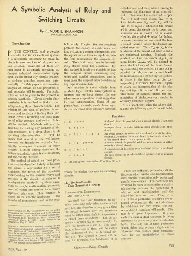
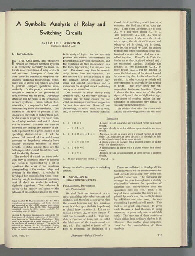

.jpg)


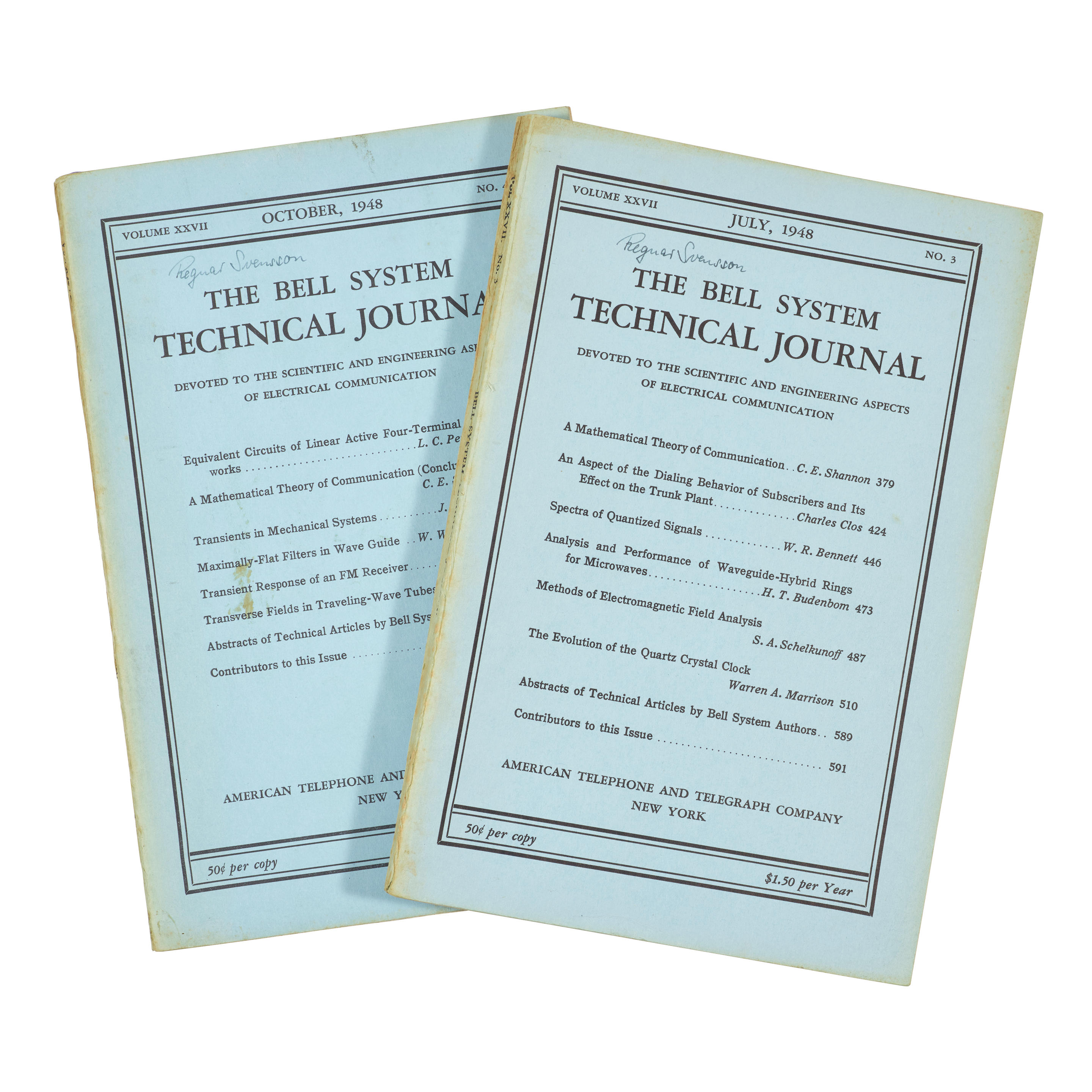

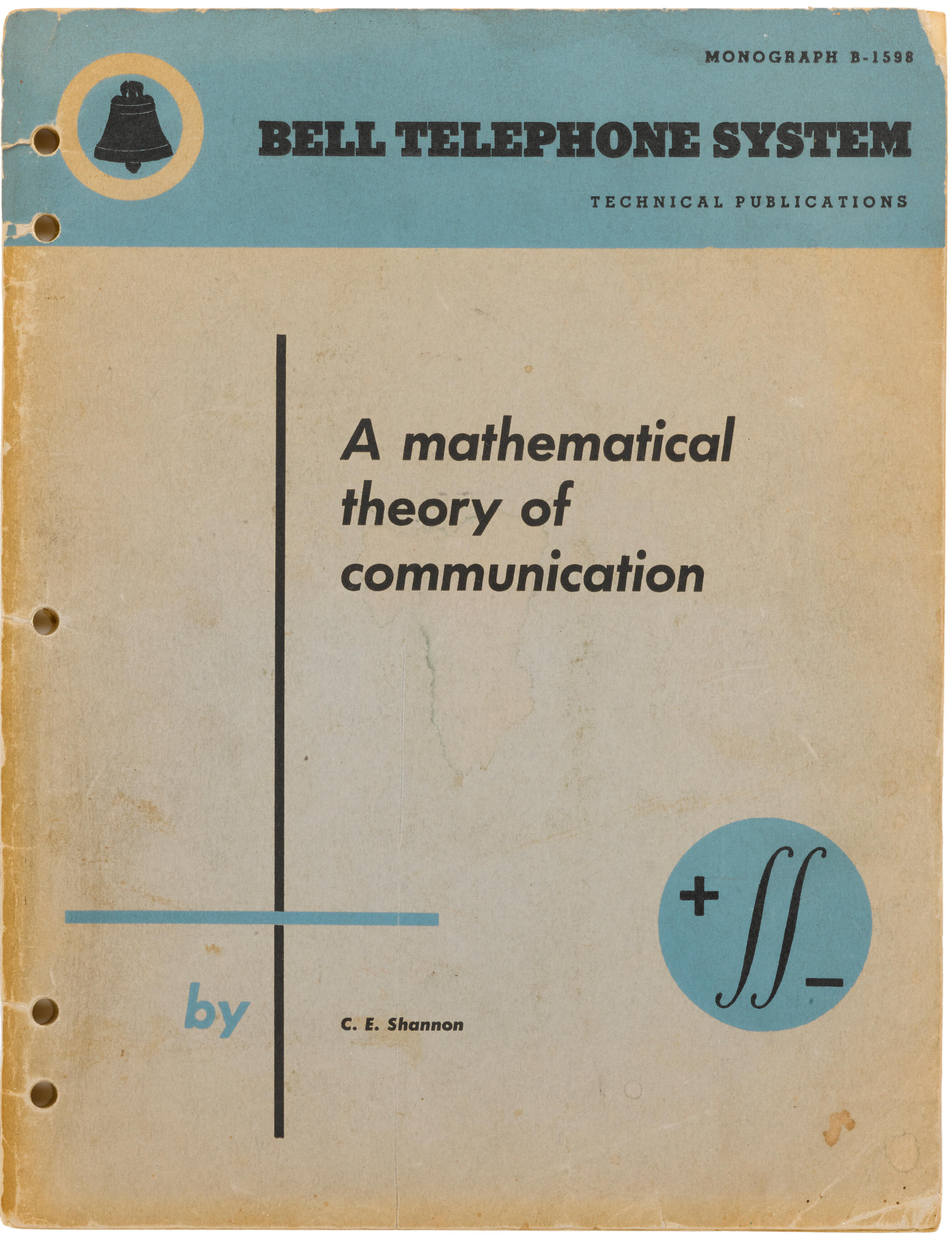


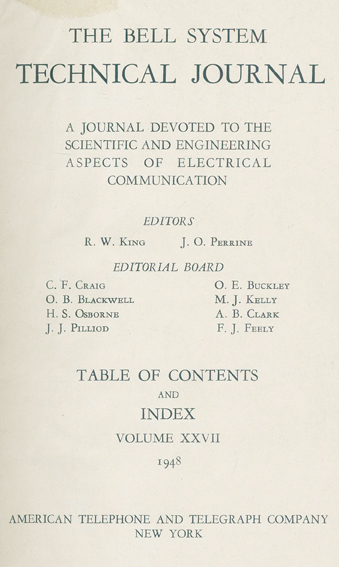


Testen Sie LotSearch und seine Premium-Features 7 Tage - ohne Kosten!
Lassen Sie sich automatisch über neue Objekte in kommenden Auktionen benachrichtigen.
Suchauftrag anlegen